Railroad Tracks a Danger to Bikers
126 bicyclists have been involved in crashes, 80 in Milwaukee.
Do railroad crossings pose a risk to cyclists? This was the question I focused on for my final capstone project as I completed my Masters in Public Health at UW-Milwaukee this past spring. Some months earlier, I had fallen victim to the tracks located at 900 W. Canal St. in the Menomonee Valley area of Milwaukee last summer. The crash landed me in the emergency room with retrograde amnesia – (yes, I was wearing a helmet!). This got me wondering how many others this might have happened to.
I came to the conclusion that I had to obtain the data myself. So, I developed a survey to identify how many cyclists have been involved at a bicycle crash at a railroad crossing in Wisconsin, with particular interest in Milwaukee County and the Canal Street railroad tracks. The survey was posted to social media by myself to the MKEBKE bike group and by the Bike Fed from March 24th to April 9th, 2017 and you can still fill it out here.
In all, 126 cyclists reported having been involved in a bicycle crash at a railroad crossing in Wisconsin, of which 80 occurred in Milwaukee County and 49 at 900 W. Canal St. In fact, I had three individuals contact me directly about their personal experiences. Two of these resulted in severe injuries and riders were hospitalized. One had a facial fracture from flying over the handlebars. The other suffered a broken collarbone. All three occurred at 900 W. Canal St. Recently, the City of Milwaukee has been in contact with the railroad about removing these tracks.
I originally planned to analyze data from open records and crash reports from the Milwaukee Police Department. However, the police department does not reliably track data for crashes that only involve one bicycle. An officer from the department stated that crash reports can only be filed if it involves a motor vehicle, pedestrian or another bicyclist. If it involves a bicycle and a railroad track, this should be called in immediately and an officer will respond and most likely the paramedics or fire department. The crash could possibly be filed as a “sick and injured” report as opposed to a crash report. Sick and Injured is not a report that is made after the fact. If an individual wishes to file a report for a past incident, they could go to the police department with documentation from the hospital and the police department would consider the type of report to classify it under. This is a problem as there is no consistent, trackable data. If bicycle crashes at railroad crossings go unreported, there is no way to bring awareness of the issue!
The problem with the Canal Street crossing is the near parallel angle of the track with the street. This inhibits cyclist’s ability to easily cross at a safe angle. Bicycle tires are narrow enough to fall into the flange way (the gap between the rail and surface of the road). This causes the cyclist to lose control of the bicycle, resulting in a crash and a potentially serious injury. The American Association of State Highway and Transportation Officials (AASHTO) suggest a preferable angle between 60 and 90 degrees to minimize the likelihood of falls. This area is also regularly utilized by cyclists due to its adjacent location to the Hank Aaron State Trail. The trail was built on a former railroad bed of the Chicago, Milwaukee, St. Paul and Pacific Railway and has been in use since November 8th, 2010. It extends 14 miles long from the shore of Lake Michigan in Lakeshore State Park to Waukesha County, serving as a transportation connection between downtown Milwaukee and the suburbs to the west for those who commute between home and work. While most of the tracks parallel with the trail have been long removed or filled in, one small remnant of tracks remains at 900 W. Canal Street and is fully exposed.
There are a number of conditions which can force cyclists into the street where they are prone to cross the tracks at a compromised angle. To the immediate west of the railroad siding, the trail narrows significantly to approximately 3 feet 6 inches because of existing fence lines along a property, in addition to light poles and a fire hydrant. AASHTO recommends that the minimum width for a bikeway be at least six feet. There are also multiple curb cuts in this area, which allow cyclists to leave the trail and enter the road, which can appear to be the safer option when a pedestrian or cyclist is passing in the opposite direction at this pinch point. Less than a mile to the east, cyclists are required to cross the street at the crosswalk to remain on the trail, which can lead cyclists to leave the trail earlier in hopes of an easier transition to 6th Street. When the cyclists enter the street, it can be difficult to notice the danger that the railroad tracks pose. Even if cyclists are aware of the danger, with two lanes of regular traffic in both directions, it can be difficult to position the bike to cross at an appropriate perpendicular angle.
The tracks that cross Canal street serve a railroad siding and adjacent property owned by St. Mary’s Cement, which is based out of Toronto, Ontario, Canada,. However, these tracks are no longer in use and haven’t been for nearly 10 years – clearly evidenced through google street view, which shows them continuously paved over by the Hank Aaron State Trail since 2007. They do not serve any active purpose for the company or the city of Milwaukee. There is no reason for these tracks to exist and I propose that they be removed or at the very least filled in. To ensure the safety for cyclists, AASHTO suggests that the width of flangeway openings be kept to a minimum. Filler products, such as rubber, can be used on low-speed rail lines. Rubber fillers work by depressing under the rail wheels, and raising after the rail has passed. The filling in or removal of this siding would improve safety for cyclists, both on the Hank Aaron State Trail or along Canal Street.
Additionally, South Water Street was the next most problematic area. Some 18 cyclists reported crashing along tracks in this area. These tracks are also nearly parallel with the street. Many cyclists end up riding in this area to avoid the heavy traffic of 1st Street and ride on the Kinnickinnic River Trail. However, the trail ends and transitions into the street with numerous abandoned rail lines. There is signage warning of the danger of crossing railroads; however, these can be difficult to see as well as understand. Even an avid cyclist who is aware of the danger of crossing railroad tracks can be put in a compromising position trying to cross tracks with vehicular traffic sharing the same space.
This issue is even more relevant as the rails for the new streetcar are being constructed around Downtown and cyclists will have an abundance of tracks to cross. Crossing at a perpendicular angle should not pose much risk. However, when cyclists are riding on the street parallel to the tracks it will be very difficult to make a left turn and cross the tracks at an appropriate angle, especially in the midst of traffic. We need to be proactive and find a way to keep cyclists safe. Where have you come across bad crossings? What about good crossings?
What to do?
-Report crashes and safety issues to local municipality and the online survey.
-Understand the Rough Crossing process and share it with municipality if railroad is not responsive.
-Cross tracks as perpendicularly as possible, 90 degrees is the best.
-Review the DOT website on Railroad Safety.
Elisa Sibinski, Bike Fed Board Member.
Biking
-
Oak Leaf Trail Projects Could Start in 2024
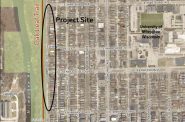 Jul 12th, 2023 by Graham Kilmer
Jul 12th, 2023 by Graham Kilmer
-
1896 Bicycle Factory Has Quite A History
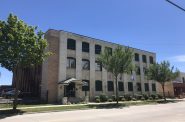 Sep 14th, 2021 by Michael Horne
Sep 14th, 2021 by Michael Horne
-
Honoring Biking Advocate Phil Van Valkenberg
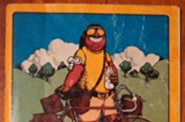 Jul 31st, 2021 by Spencer Black
Jul 31st, 2021 by Spencer Black
Transportation
-
Congestion Pricing Cuts Air Pollution in New York City
 Dec 14th, 2025 by Jeff Wood
Dec 14th, 2025 by Jeff Wood
-
FTA Tells Milwaukee to Crack Down on Fare Evasion — Even Where Fares Don’t Exist
 Dec 12th, 2025 by Graham Kilmer
Dec 12th, 2025 by Graham Kilmer
-
Will GOGO’s Bus Service Ever Get Going?
 Dec 9th, 2025 by Jeramey Jannene
Dec 9th, 2025 by Jeramey Jannene

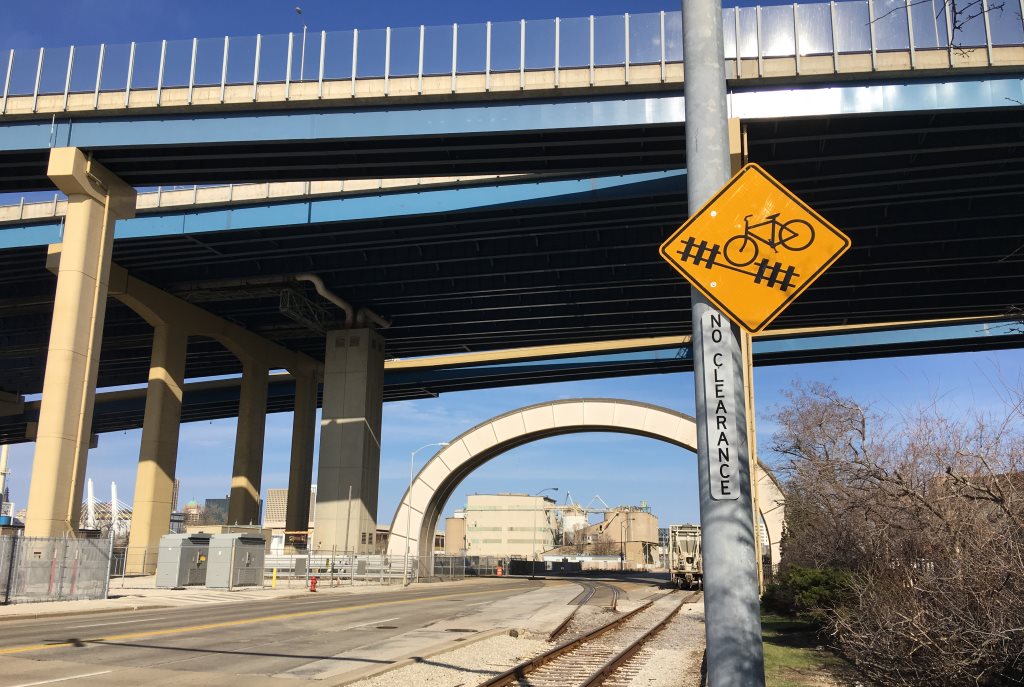
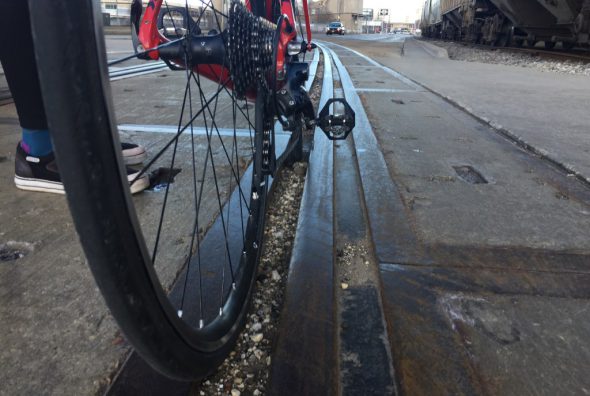
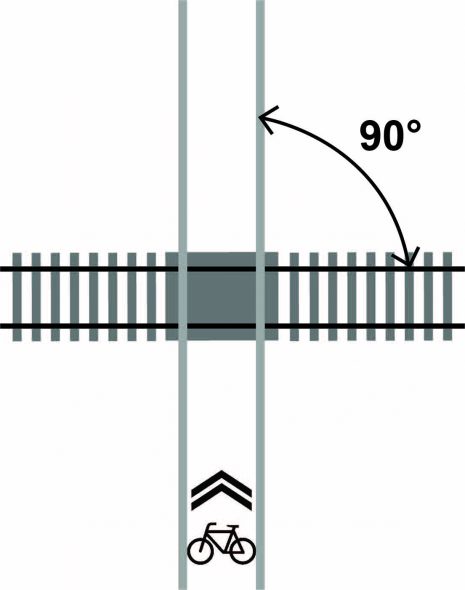




















The kk river trail lines aren’t abandoned. Trains use those ones in the road… it’s a really wierd experience because they operate in the middle of an active road.
I think this is generally avoidable with caution but agree that turning left downtown in traffic will now be impossible without jumping skills on the bike dueto the streetcar. The cyclist will need to swing all the way out to the right to turn left over the tracks, impossible in traffic.
The other two mentioned are bad, but traffic is usually non existent so the cyclist can use every Lane to safely cross.
The South Water St section of the KK River Trail and all of the rail crossings was brought you by the suburban project team of the Wisconsin Dept of Transportation headed by Project Mgr Ryan Luck. Milwaukee cyclists deserve better.
Be aware of your surroundings. Problem solved.
Cyclists vs. streetcar track. What does an urbanist do?
I realized this summer that the South Water Street section of the KK River Trail is meant to be ridden on the sidewalk … (being a good cyclist, I bike in the street!) but based on the signs posted, and the painted yellow line in the “sidewalk,” I ride on the “sidewalk” on South Water for that gnarly track section.
Get off your bike and walk it over these obstacles especially in traffic . It’s good to stretch out your hips and take the pressure off your butt during a long ride.
I was on the South Water Street section of the KK River Trail last summer and saw an ambulance with EMTs attending to a fallen cyclist at that bad track alignment place. A couple of weeks later I again rode through that area with my wife and son, who was on a tandem, and warned them about the railroad crossing. We had no problem. But it could have been. Many years ago, in the 1970s and 80s, I regularly rode on South Water St and the tracks were even worse back then so I knew they can be dangerous.
We ride trikes now, a bit safer over tracks, but they can still flip.
I’m happy you mentioned the stretch on South Water Street. When WisDOT held two years of meetings for a Bay View-Downtown bike path, and delivered only this modest trail, we were advised (about the problem of the rails) that there is a “technology” that would protect bicycles from getting caught in the rail’s gap. Nothing ever happened, no explanation, and there was plenty of money to get the project done correctly. The rail tracks that are left are still in use for hauling material out of metals dump to the east of the South Water. Some solution – whether we can get WisDOT to pay for it or not – would seem to be the right thing to do.
I recommend a 6-foot or wider bike lane particularly to encourage auto drivers to move away from the tracks and by doing so give the bicyclist the kind of turning space needed to cross at 60+degrees.
Elisa, kindly add this to your most welcome report.
… um, that would be a 14+ foot wide bike path …
Railroad Tracks a Danger to Minority Bikers.
“This issue is even more relevant as the rails for the new streetcar are being constructed around Downtown and cyclists will have an abundance of tracks to cross.”
Just another addition to the list of why the silly streetcar is a bad idea. I won’t be concerned about this, though, inasmuch as my bike will remain indoors on its rack until such time as I find a comparable place to live away from the streetcar line alongside my apartment and adjoining streets. I will be walking more than ever and watching the thing go around in circles, just I did at my cousin’s home after his dad helped him build a spectacular Lionel train layout in his basement.
Should I live long enough I expect the rails will be paved over, the ugly wires taken down, and Milwaukee will emerge (again) from the early 1900’s with the predictable outbreak of nostalgia from the few and the expressions of relief from all the rest of us.
Today we hosted ex-Milwaukeeans who moved to Colorado a few years ago. They were amazed to see that the streetcar was actually being installed. When they asked “Why?”, I just shrugged and opened another beer, saying, “let’s talk about something else, okay?” It’s embarrassing.
FYI: Denver has light-rail running on its streets.
I am nothing like an expert cyclist, but I would consider myself near expert on rail subjects. The rails on Canal Street and the streetcar tracks look the same to most people, but examine more carefully; the flangeways (that groove just inside the tracks) is twice as wide and twice as deep on railroad tracks compared to streetcar tracks. That makes the streetcar far less of a challenge, and you honestly don’t need to cross at 90 degrees. So long as your wheel is not so parallel that it gets stuck in the flangeway, you’ll have no problem. With a combination of awareness and a minor amount of skill, this seems to be no particular issue. Experimentally, using a rented Bubblr bike, I was able to weave back and forth across the streetcar tracks on Ogden at angles as shallow as 40 degrees, and without the slightest issue.
As with anything on a bike, use caution and experiment carefully. But I suspect you’ll quickly find this to be no more an issue than uneven pavement.
Dave Reid, I’m sure you have more data and command of the subject than I, but I do try to take note of developments and assessments of the success of these initiatives. Having lived a long time in the Chicago area, I completely understand how essential rail CAN be where the demographics and geography justify (“require”, actually, in Chicago and other cities) its construction and use.
Denver is not Milwaukee-like in very many ways so I’m not sure how relevant their experience is. And I haven’t been there in a couple of decades, so have not seen its light rail in service. I have to rely on articles and media-expressed opinions about Denver’s RTD. When one Googles, it’s easy to find quite a bit of Monday-morning-quarterbacking which mostly amounts to admitting that predictions of ridership were overstated, and projections of cost were understated (what a surprise!). My friends from the Denver/Boulder area are not the “target market” for rapid transit but they don’t cite it as a “plus” there from what they know of it. Here are some paraphrases from an article (they are easy to find), pretty typical:
Ridership on Denver’s new R and W light-rail lines is so low that RTD is reducing train frequencies.
Due to overruns that nearly doubled construction costs, RTD is unlikely to finish all of the lines promised to voters in 2004 without another tax increase. Those cost overruns have also harmed bus riders, who — instead of the enhanced bus service promised by RTD — saw service decline from 39 million bus-miles in 2004 to 36 million in 2015, with more cuts expected in the near future.
According to the Census Bureau’s American Community Survey, the share of commuters taking transit to work in the Denver-Aurora urban area shrank from 5.4 percent in 2006, before any of the new lines opened, to 4.6 percent in 2016, when several new lines had opened and existing ones extended. Though congestion reduction was a major selling point to voters, the trains actually made congestion worse through frequent delays at grade crossings.
RTD’s ridership peaked three years ago, with the first eight months of 2017 seeing 5.1 percent fewer riders than the same time period in 2014. This reflects a national trend, as transit ridership is falling in every major urban area except Seattle.
Funny thing about RTD’s dropping ridership: the majority of long term loss has been bus.
bus rail
2016 73,252,352 24,585,082
2015 75,502,787 25,518,578
2014 76,657,870 26,363,053
2013 76,348,670 23,773,844
Bus has dropped every year, while the light rail has been consistently high, and ends near a million more than in 2013. All data is noisy, and factors like leap years and the exact patterns of holidays figure into any transit. But this seems pretty consistent.